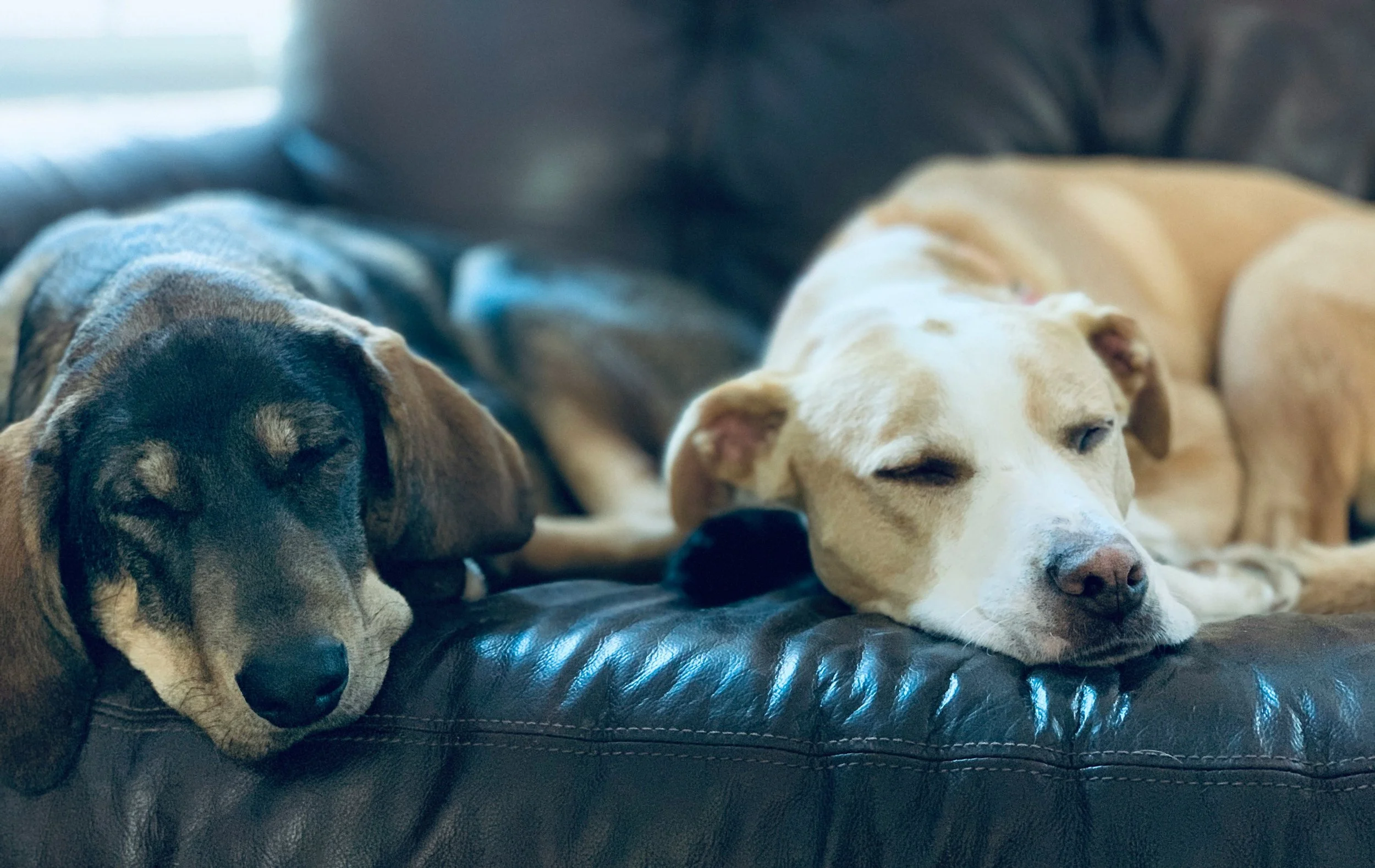Can Two Dogs Who Fought Ever Live Together Again?
If your dogs have fought it’s one of the most stressful situations you can be in as a dog owner.
It’s scary, it’s emotional, and it often leaves people feeling lost. You love both of your dogs and you want things to go back how things were before.
A question we hear all the time is: “Can my dogs ever live together again?”
The honest answer? It depends.
Let’s walk through what causes intra-household aggression, what recovery can look like, and how to set up safety and structure in the meantime.
Why dogs fight in the first place
When two dogs who live together suddenly start fighting, it can feel totally out of the blue.
But there’s almost always a root cause.
Resource guarding: One dog is guarding food, toys, spaces, beds, crates, or even a person.
Unresolved tension: Minor warnings or body language have been ignored or misunderstood over time. If you’ve missed them, don’t beat yourself up!! They can be very subtle to the human eye.
Pain or medical changes: This is a big one! A dog in pain may react faster or with way less tolerance than they usually would have.
Frustration or stress overflow: Built-up energy, lack of boundaries, or poor rest can create tension. Think about over tired toddlers who really need a nap.
Social mismatches: Different play styles, age gaps, or personalities that don’t mesh well.
Lack of structure: Inconsistent rules, unclear leadership, or a free-for-all dynamic in the house. Please note: This is totally unrelated to the de-bunked theory about dog/owner dominance!
Sometimes a fight is a one-time explosion. Other times, it’s the result of a long pattern of low-level stress between the dogs that finally boiled over.
What to do after a fight
Separate the Dogs
Keep them physically separated until you’ve had time to assess the situation with a private trainer. That means different rooms, crates, pens—whatever it takes. This isn’t a punishment, it’s about giving everyone time to decompress.
Don’t Rush a Reintroduction!
Even if things seem fine the next day, putting them back together too soon can lead to another fight (often more intense than the first). Let things cool down. Trust me, they will appreciate this.
Start Observing Closely
Think back: Were there warning signs?
Has one dog been avoiding the other, stiffening up, growling around food or toys? Was there a trigger, or did it seem random?
The more context you have, the better a trainer or behavior consultant can help.
Start Muzzle Training
A key safety element for reintroductions and long-term management.
Safety & management come first. Always.
Whether or not the dogs can live together again, you’ll need a solid safety plan in place moving forward:
Gates, crates, and pens
Keep the dogs separated when unsupervisedStructured routines
Reduce stress and uncertaintySupervised time only
If/when they begin to interact againSeparate feeding, resting, and toy zones
To prevent conflictAvoid high-energy moments
Llike greetings, transitions and new things, unless you’re actively managing
We always say: You can’t train through a safety issue. If your dogs are at risk of injuring each other, management isn’t optional, it’s necessary.
Can they coexist together again?
Maybe. But not always, and definitely not right away.
We’ve seen dogs successfully re-integrate after serious fights, but only when the situation is handled with structure, safety, and the right training approach.
In some cases, peaceful co-living isn’t realistic or fair to one or both dogs, and that’s okay, too. The goal is safety and quality of life for everyone involved. Including you!
What reintroduction might look like
If reintroduction is the goal, it should be done carefully and gradually with a certified dog trainer. That often looks like:
Parallel walks
Visual access at a distance
Neutral territory exposure
Short, structured sessions with supervision
Building positive associations without forcing interaction over a long course of time
Wearing muzzles around one another
This is not a quick fix. It can take weeks, or longer, for progress to happen. And that’s okay!! As long as you’re dedicated to the process.
When rehoming is the kinder option
This decision can and should take time, thought and collaboration with your vet, trainer and if relevant, your dog rescue.
It’s hard to talk about, but sometimes the kindest, safest option is finding one dog a new home.
If both dogs are living in a constant state of stress or fear, or if serious injury is a real risk, a thoughtful rehoming decision can improve quality of life for everyone, including the humans.
It’s not failure. It’s compassion.
Need Help Making a Plan?
At Copilot Dog Training, we’ve helped families navigate complex, emotional situations like this. We’ll never give you a one-size-fits-all answer. Instead, we’ll work with you to assess what’s happening, prioritize safety, and figure out what’s realistic for your dogs and your life.
Frequently Asked Questions
Q: They fought once and haven’t since. Should I still be worried?
Just because it hasn’t happened again yet doesn’t mean the tension is gone. Prevention is key.
Q: Should I let them “work it out”?
No! Dogs that escalate to serious fighting are not going to resolve things safely on their own. That approach is risky and outdated.
Q: Can training really fix this?
Training can help if the root causes are identified and addressed and if safety and structure are consistently in place. But some situations are beyond what training alone can fix.
Q: What if I’m not sure what triggered the fight?
That’s very common. A behavior professional can help you identify subtle patterns or stressors you might not have noticed.




